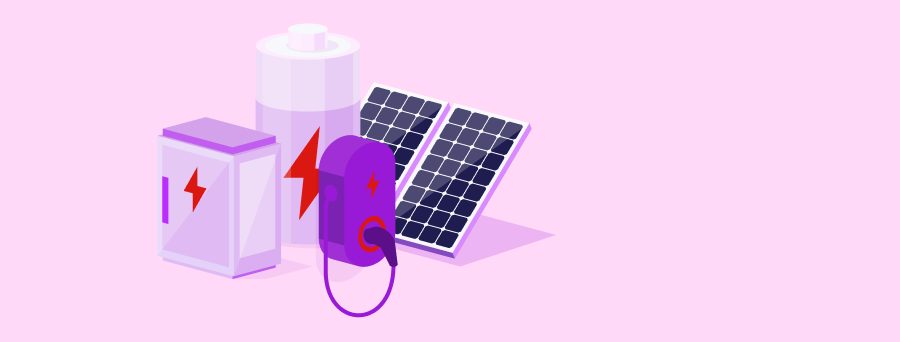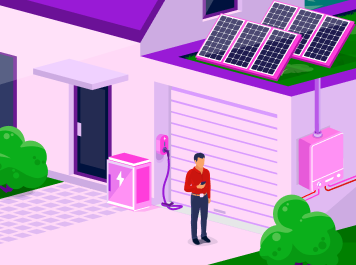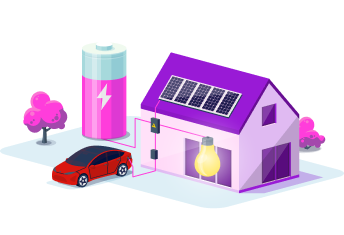
Eligible Upgrades: Sustainable Upgrades home loan
Before you buy and install upgrades
It's important to get independent professional assessments and checks to ensure they’re right for your home and local climate. You can consult with experts like builders, engineers and suppliers. You can also compare different quotes to find the best one for you.
Explore how you could upgrade your home

Discover estimated energy bill reductions with Cogo’s online Home Energy Tool
Cogo’s Tool quickly estimates the energy efficiency of a comparable home to yours.
In minutes, get energy-efficient upgrade suggestions and information on:
- Typical upgrade costs
- Estimated energy bill reductions, and
- Potential rebates
Energy-efficiency: What type of upgrades can I make?
You could manage your energy consumption, with a choice of 10 eligible upgrades. Remember to do your own research and gather quotes before applying for a Sustainable Upgrades home or investment loan.
Solar panels (and inverters)
- Solar panels listed under the Clean Energy Council (CEC) list of approved solar modules
- Solar panel system size equal to or greater than 5 kilowatts (kW)
- Inverters listed under the Clean Energy Council (CEC) list of approved inverters
Solar batteries
Solar hot water system (including removal of gas connections and appliances)
Hot water heat pump (including removal of gas connections and appliances)
Double glazed windows
EV charger
Induction cooktop (including removal of gas connections and appliances)
Climate-resilience: What type of upgrades can I make?
Bushfire
- Flooring system with non-combustible materials
- External walls with non-combustible or fire-resistant material
- Roofing with non-combustible materials, sealant and coating: Tiles, sheets and covering accessories, framing, external finishes and insulation; full sark sheet; tiled roofs
- Window fixings: non-combustible window frame; metal flyscreens or shutters; toughened glass in window glazing; fire rated window
- Doors built with non-combustible material or solid timber
- Doors with metal screens or bushfire shutters
- Fully framed glazed doors with the frames constructed of a bushfire-resisting timber
- Weather strips
- Draught excluders, or draught seals
- Fencing within 1.5m of the property using non-combustible materials, like cement fibre, metal, chain link or stone
Flood
- Raise above flood levels: Air condition condenser units, electrical systems and switchboard (including data and electrical points), hot water unit and water tank
- Separate circuits with breakers on upper and lower levels
- Solid core, aluminum, glass or corrosion resistant doors, frames, and windows
- Permeable garage doors
- Flush door thresholds, including removing all thresholds that obstruct drainage and discharge of flood waters
- Sealing frames to building fabric
Storm & cyclone
- Solid core doors, drop bolts and heavy-duty hinges to withstand wind loads
- Windows for improved wind rating (including water penetration performance), including window seals and configuration of weep holes
- Cyclone screens or shutters over windows to protect from debris
- Over batten roofing system
- Replace rusted or rotten structures (e.g. a rotten timber batten)
Things you should know
Conditions, credit criteria, fees and charges apply. Residential lending is not available for Non-Australian Resident borrowers.
This information is general in nature and has been prepared without taking your objectives, needs and overall financial situation into account. For this reason, you should consider the appropriateness of the information and if necessary, seek appropriate professional advice. This includes any tax consequences arising from any promotions for investors and customers should seek independent, professional tax advice on any taxation matters before making a decision based on this information.
1Cogo: The Home Energy Efficiency Tool (the Tool) is offered by Cogo and not Westpac Banking Corporation (Westpac). The Home Energy Efficiency Tool is not exclusive to Westpac customers. Use of the Tool is not required to apply for a Sustainable Upgrades Home or Investment Loan.
By accessing Cogo's Tool, you will enter a third-party site not owned by Westpac. Any personal information you provide to Cogo's website will be collected, used and disclosed in accordance with Cogo's Privacy Policy, also available on their website.
Cogo is responsible for the accuracy and completeness of the information provided by the Tool. Westpac gives no representation, warranty, or guarantee (including as to the quality, accuracy or completeness) of the information. You can access Cogo’s disclaimer on their website.
Westpac has paid Cogo a fee for the provision of the Home Energy Efficiency Tool. Cogo is not a referral partner of Westpac for consumer credit, including in relation to the Sustainable Upgrades Home Loan (SUHL). Westpac does not and will not pay or receive any commissions to or from Cogo for customers who take up the SUHL. Cogo will not provide any credit assistance to Westpac customers.
You should carefully consider whether the information provided by Cogo is suitable for your situation. We recommend seeking independent professional assessments and obtaining quotes to ensure the upgrades are appropriate for your home and local climate before making any changes.
